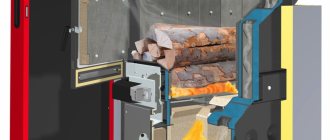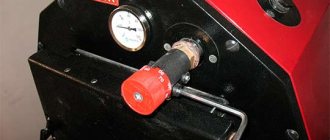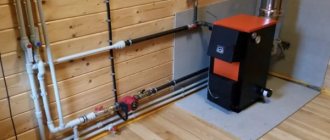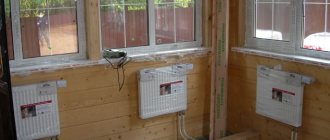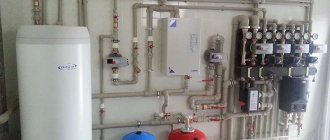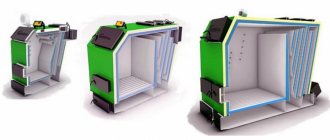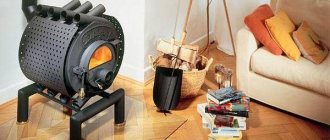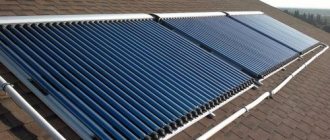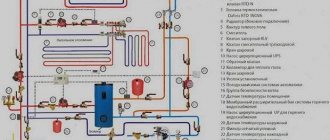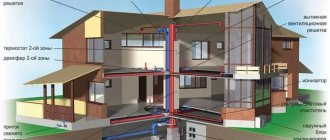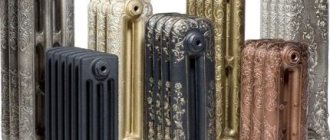Features of operation of a solid fuel boiler
In the absence of a natural gas pipe connected to the house and the high cost or impossibility of connecting electric heating, owners of private houses have only the option of heating with a solid fuel boiler. When operating this type of equipment, there are several nuances that every owner needs to know about. Let's look at the main ones.
Constant service
. This type of heat generator runs on wood, peat briquettes, anthracite or coal - fuel that must be added manually. The ash formed during the combustion process settles inside the firebox, and combustion products in the form of soot accumulate on the inner walls of the chimney. It is necessary to monitor the operation of the equipment and clean the firebox at frequent intervals.
Thermal inertia
. In comparison with a gas or electric unit, it is not possible to stop the fuel combustion process in a high-pressure boiler. Sudden temperature changes significantly reduce the service life of a solid fuel device, so extinguishing fuel (filling it with water) is strictly prohibited. To reduce the temperature of the coolant, all that remains is to wait until the raw material burns out or the oxygen in the chamber that supports the flame runs out.
Formation of condensation on the walls of the heat exchanger
. A situation arises when the temperature of the coolant in the return pipe drops to 25-40° C. The steam generated during combustion cools down and turns into an aggressive liquid, which can eventually destroy the walls of the heat exchanger. To prevent the formation of condensation, a small circuit is made near the heating boiler, which first heats the boiler, and then only supplies heat to the heating system. A special thermostatic three-way valve helps with this.
Lack of automation
. Classic models of units are not equipped with an automatic flame control system and they do not have high-precision control of liquid temperature, as in a gas boiler. Often, the coolant can heat up to a critical level of 100° or higher and cause the heat generator to boil, which can become dangerous for the entire system as a whole. A buffer tank, which is connected to the boiler under natural circulation, will help protect the boiler room from such unforeseen situations and prevent the boiler from heating up to a temperature above 100°C.
Therefore, the main problems that can arise if the strapping is incorrect:
- overheating of the coolant and water hammer,
- formation of air pockets,
- increased frequency of fuel loading,
- formation of ash and condensation.
A pellet boiler can partially solve these problems. As is known, pellets are characterized by low ash formation and less soot accumulates during the combustion of such fuel. With automatic supply of pellets to the burner, it is possible to regulate the loading volume and heating intensity, and, if necessary, almost completely stop the combustion process.
The use of a long-burning boiler with built-in automation that controls the combustion process of raw materials will also allow you to approach the unit less often for refueling and increase the heating period of the house.
Power
This is an important point to consider. The calculation is made according to the formula for 10 sq.m. 1kW. But these are just approximate numbers. Two categories can be distinguished: up to 100 kW (intended for individual use), and more (used in large factories).
There must always be a reserve of power so as not to create excessive load. Thanks to this, they will work more productively and longer. Don't forget that this also depends on what is being burned in there.
Boiler piping diagrams
To avoid premature breakdowns, irrational use of raw materials and rapid cooling of the premises, it is necessary to carefully consider the connection diagram of the boiler heating system with other piping elements.
The main elements that must be installed in the boiler room together with the heat generator include:
- security group,
- buffer capacity,
- circulation pump,
- expansion tank,
- mixing unit or three-way valve.
Fuel types
It is possible to use a specific type, or a combination of them (more expensive to use and maintain, but more versatile).
There are three main ones:
- Coal
- Firewood
- Pellets (fuel capsules)
In addition to them, in some situations, waste from agriculture or the woodworking industry is used.
When choosing coal, you should take into account its fraction and grade, namely, their coincidence with operating conditions. When choosing firewood, you need to focus on its moisture content - it may not suit you.
When choosing pellets, consider the material from which they are made.
Scheme No. 1
The simplest diagram for connecting a solid fuel boiler in a closed heating system is as follows:
The installed safety group controls the maximum permissible pressure level in the system and, when a critical level is reached, automatically releases the pressure and removes the resulting air. An expansion tank is installed between the circulation pump and the boiler to collect excess water or compensate for fluid in the circuit.
Important! The safety group is installed in front of the solid fuel boiler. The presence of shut-off valves between the heat generator and safety devices is not permissible.
Scheme No. 2
However, the first scheme is not the most effective. The water in the boiler return may already be cold, which contributes to the formation of condensation and soot in the furnace. To prevent this, a three-way mixing valve is installed on the outlet pipeline to mix hot water from the supply pipe.
Scheme No. 3
For greater efficiency and productivity of the system, a buffer tank (the so-called “heat accumulator”) is used when piping the boiler. The inlet and outlet pipes of the solid fuel boiler are connected to the buffer tank, forming two heating circuits: the boiler circuit (between the heat accumulator and the heat generator) and the heating circuit itself. This scheme allows you to protect the boiler from overheating and accumulate heat. This way you can save on fuel and add raw materials less often.
Important! It is necessary that the power of the solid fuel boiler be calculated correctly and be enough to heat the home and operate the heat accumulator.
Scheme No. 4
A hydraulic arrow will also help cope with pressure surges in the system. As a rule, it is installed in houses with a large area and a complex heating scheme (the presence of a heated floor or two radiator circuits) together with the use of a group of collectors.
Important! The hydraulic separator, like the heat accumulator, is selected depending on the power of the heating unit.
Read more about hydraulic arrows in the article: Hydroarrow: purpose, operating principle and connection diagrams.
Closed type
A closed system of pumpless coolant circulation is successfully used for heating one-story and two-story houses. It functions as follows:
- when the coolant expands, excess liquid is forced out of the heating circuit;
- the liquid enters a membrane-type expansion tank - this is a closed container with an elastic membrane that separates the part intended for the coolant and the section of the tank filled with air or nitrogen;
- the heated liquid stretches the membrane, compressing the gas in the second section of the tank; when the coolant cools, the gas expands and pushes the liquid back into the system, as a result of which the water circuit constantly remains full.
Installing a membrane tank in a gravity heating circuit reduces the risk of corrosion of the metal elements of the system. But in Russia, this solution is used relatively rarely, since the cost of a membrane tank is several times higher than the cost of purchasing or independently manufacturing an open-type tank.
Basic connection tips:
- Organize a place to install a solid fuel boiler and related equipment. Ideally, this should be a separate room with a ceiling height of at least 2.4 m and good supply and exhaust ventilation. The installation site of the heat generator must be lined with fire-resistant material.
- Install coarse filters directly in front of the circulation pump. This way you will protect the boiler from unnecessary sludge and protect the equipment from rapid wear.
- When using a hydraulic arrow and a buffer tank, install circulation pumps on each heating circuit.
- Install a UPS or stabilizer in case of power surges.
- Use threaded fittings. If one of the elements of the system fails, you can quickly change it without having to completely drain the coolant.
Rules for installation and arrangement of a boiler room
For convenient operation, the installation of a pellet solid fuel boiler must be done in a spacious room. When placing it, it is necessary to comply with the parameters of technological distances from walls and other surfaces, which are indicated in the product passport.
In practice, there have been cases when, after six months of operation, it was discovered that it was impossible to open the ash pan to clean it.
The main criterion for the suitability of a room is good natural or forced ventilation and a properly constructed chimney. You can see the most commonly used chimney design diagrams below:
Diagram A and B of a chimney in a house. Ventilation shafts located in the walls are used as an exhaust duct. These channels must be isolated from the main natural ventilation system of the house.
Scheme B - removal of the chimney from the boiler room located in the basement.
Schemes D and D for the installation of an external chimney from a specially built boiler room or room in the house.
In all chimney installation options, it is necessary to install:
- spark arrester for the chimney;
- sealing the transition hose to the boiler room;
- drainage device.
It is recommended to install a solid fuel boiler on a foundation pad with a heat-insulating layer. It is necessary to install a special gas analyzer in the room if this is not included in the standard configuration of the purchased model.
Rules for installing a pellet bunker
In addition to the built-in hopper, which has a small volume and must be filled with fuel frequently, many owners connect an external large-volume hopper to the system.
Any container is suitable for storing pellets, the main condition is the tightness of the structure if it is located outside the heated room. When choosing the volume of the bunker, you must proceed from the standard: 1 ton of pellets takes up to 2 m3. the height of the structure is not a critical value.
There is an opinion that in high containers the lower layers of granules are crushed, this is not true. High-quality fuel pellets can withstand quite high pressure.
The container should be located no further than 12m from the boiler. It is possible to complicate the design of the auger or use transfer storage bins, but only high-quality fuel must be used. Otherwise, dust entering the firebox in large quantities will reduce efficiency and may damage the boiler’s feeding and dosing mechanisms.
In the lower part of the bunker cone, under the fuel intake outlet, it is necessary to provide an inspection for the systematic removal of debris. If the cone has a small cross-sectional area, the masses of granules compressed under pressure freeze. In this case, it is recommended to install a special device “screw agitator”.
Bunker connected to the boiler.
Which home heat is more economical?
I can say with confidence that heated floors will be the most economical in a country house, because hot air is generated from below and gradually rises upward, uniformly heating the entire area of the room.
Walking on such a surface is very comfortable, especially if the floors are filled with materials that are cold in structure or have tiles on them. To install this type of system, you can use water or antifreeze as a coolant and elements powered by electricity of your choice.
Customer Reviews
Ignat K.
Protherm Beaver 50 DLO 39 kW
Advantages: It has been working since 2014 with virtually no complaints. At the same time, only one inspection took place (one year after installation). Disadvantages: It often turns on to maintain the temperature; it can turn on/off 2 times in 10 minutes. I would like to adjust the hysteresis of the tº spread. After 6 years, something began to squeak when the pump rotates. Comment: One winter it turned off with error F5 - problems with traction. After I removed the ice that had formed from the pipe (and there was actually a lot of it frozen after the snowfall and severe frost), the problem was solved. It seems to me that those who get their entire controller replaced for the F5 error are simply being scammed out of money.
Novel
Teplodar Cooper Praktik 8
Advantages: Electronic control. Quiet operation. Weekly timer Connection of an external thermostat Burner modulation Built-in expansion tank Possibility of using non-freezing coolant Disadvantages: Operation of an anti-freeze system. The manufacturer cannot provide information on the OpenTherm interface, which is declared in this boiler, and the equipment compatible with it. Comment: I was a little disappointed by the breakdown. Immediately after the initial startup, the system board needed to be replaced - the system did not see that the burner was lit. But the issue was resolved directly with the manufacturer. I received the new fee by mail 4 days after applying. I installed it myself. Everything has been working fine for a year now. The service is fine. Incomprehensible anti-freeze system. The pump turns on at +8, turns off at +12, and the burner turns on at +5. And if the temperature falls into the region of +10, then the circulation pump works for days. And if non-freezing coolant is filled in, then this system is not needed at all.
Vladimir Malvinov
ZOTA Box 8 8 kW
Advantages: Good and reliable boiler Disadvantages: I haven’t found it in a year Comment: On the advice of friends, we purchased a boiler. A voltage stabilizer was immediately purchased; in our village we have large power surges, the lights blink frequently. For almost a year of operation, the boiler has never been repaired, only scheduled maintenance. . The reliability and safety of the boiler is also at the highest level. Heat exchangers can withstand the test of fairly hard water. There are no complaints, we are completely satisfied with the purchase, everything is simple and clear. I advise you to buy!
Kirill M.
ZOTA Topol-22VK 22 kW
Pros: Excellent boiler. There are commissioning features. Reading the manual!!! By default, the turbo water heating mode is set, which is needed if you have a long distance from the boiler to the point of water consumption; the water is heated to 70 degrees immediately. If you have a bathroom behind a wall, it is better to turn off this mode in the settings. In the second mode, the boiler is set to maximum heating output, so if you place the boiler in a small room, it is better to also reduce the heating. This is important, and then you will be happy and there will be no problems with operation. And also, if there are problems with water pressure, then install a mixer with separate valves (do not install joysticks), but this applies to any boilers.
Vasily D.
ZOTA Topol-16VK 16 kW
Advantages: Relatively compact, somewhat stylish, the interface is clear from three notes Disadvantages: Not eternal Comment: I used it for two years and had no problems. Now I don’t know either, only the boiler has become a little louder. If I get tired of it, I’ll take it to the service center with a guarantee. I don’t really understand people who expect their systems to work forever and without problems, everyone’s water is different, and the hands of installers and servicemen are screwed differently every now and then. I took the extended warranty and can continue to live in peace.
Nikolay V.
ZOTA Topol-32VK 32 kW
Advantages: Reliability, functionality Disadvantages: Noisy Comment: Last year we selected a gas boiler for heating. We looked at more than one option and chose the Lemax Premium-30V boiler. We consulted with neighbors and gas workers. We looked on the Internet. Lemax is produced in Russia. This means they are adapted to our Russian realities, unlike imported ones. This is a floor-standing, double-circuit boiler with an open combustion chamber; combustion products are removed naturally through the chimney. It will heat the house and heat the water. Electronic control. The quality is top notch. This is confirmed by those who already use such boilers and those who service them. The boilers are reliable, and if something happens, they are repairable. Spare parts are always available and at low prices compared to imported ones. We ourselves were convinced of the quality of the boiler. Last winter, and it was frosty, he proved himself to be the best.
Ignatov B.
ZOTA Topol M 14 14 kW
Advantages: compact, does not require an electrical connection, economical, easy installation and management. Disadvantages: everything suits me, otherwise why would I buy it. Comment: If you are looking for a good, high-quality boiler that is easy to install and control, then Lemax Patriot-16 is the best choice. I installed it in my apartment and am completely satisfied with its performance and functionality. In addition, I began to pay several times less for heating when I connected autonomous heating and refused the services of the heating network. The boiler does not require connection to the electrical network, which was also important for me. And the fact that the boiler is floor-standing is also a small thing; it doesn’t take up much space and fits perfectly into the overall interior.
Mikhail D.
Lemax Forward-16 17 kW
Pros: Good appearance, not embarrassing to hang. Disadvantages: Error e48 Comment: Selecting a double-circuit boiler took a long time and painfully. In the end we settled on Lemax Prime-32. I liked the boiler for its unobtrusive appearance (it hangs on display) and the quality of its build. It works flawlessly, high-quality automation and reliable security systems are installed. At first, after starting there was a problem - the injector was burning with a red-blue flame, a service specialist was called. Even a child knows that fire should only be blue. The reason turned out to be excessive pressure in the system, after adjustment everything became normal. We are happy with the boiler; there is enough power for both heating and hot water.
Vladimir Malvinov
Bourgeois-K MODERN-12 12 kW
Pros: Yes, everything is good. Quiet, stable, I almost forgot about him that he existed. Disadvantages: EA’s favorite mistake, but it’s solved, I’ll tell you how below. Comment: I installed it at the dacha, connected it and configured it myself. Powered by LPG from a gas tank. Installed it, configured it according to the instructions and everything worked. A day or two and a “favorite” mistake. It starts up normally, then goes into it (I don’t know about others, but for me it popped up right at the moment the burner started). I started racking my brains. After a day of experimenting, I finally discovered the reason. The boiler starts up very smoothly and silently, the burner slats light up smoothly, one after the other. But!!! The burner igniter and the flame control electrode are located at the maximum distance from each other. As a result, sometimes the flame simply did not have time to reach the flame control electrode in a given time (the boiler has a certain time constant in its brain during which the flame should appear), the boiler, accordingly, thought that was all, and attempted to restart. Everything was repeated, and if (in my opinion, on the third attempt) he still didn’t see the flame, he fell into error. (Here I’ll get ahead and say, based on the results of observations, the speed at which the flame passes through the lamellas of the burner depends on the gas!!! From one filling it goes slowly, from another it goes much faster.) Step one - moved the flame control electrode to a different position (provided there is another place for it closer to the igniter). The situation has improved, but not completely. I thought some more and did it - The second step was to slightly increase the gas pressure in the minimum power mode (by 7 percent, from that recommended by the manufacturer) That's it. The flame consistently manages to reach the control electrode within the required time interval. More than 3 years have passed, I saw this error only twice during this time - I was a fool myself, I missed the moment when it was necessary to refill the gas tank and the gas simply ran out. The idea that this might be related to the quality of the gas came to me almost immediately. Therefore, I began to monitor the ignition of the boiler after each refueling. And I discovered that at different gas stations, the speed of flame spread is different. Somewhere faster, and somewhere slower.
Rashid Khalikov
TRAYAN T-20-1KT
Pros: Great boiler! Installed and started immediately. There is not a word in the instructions that to connect to wi-fi you need to screw the antenna to the module. The place where to screw the external antenna is described in the instructions as a “Technical plug”; to enable the detection mode, you need to press two keys, but it does not say what exactly when the boiler is turned off. In general, everything worked out using the “poke-poke” method! Disadvantages: An ordinary Russian person, after reading the instructions 5 times, will not be able to set up the boiler without having the skills to “poke” all the buttons. Update the instructions for this model, the wi-fi indicator is either on or blinking, and not as indicated in the manual. Otherwise everything is fine. I connected a temperature sensor in the house and set temperature-dependent modes. Everything works like clockwork.
Dmitry Zyuzin
ZOTA Topol-22VK 22 kW
We have been using this boiler for a season now. Of course, we had the boiler installed by specialists. At the beginning I had difficulties with the setup, but when I figured it out it turned out to be easy and simple. When the boiler is operating there is no noise, you can hardly hear it, in silence you can actually hear it turning on and off a little, but not much. Moreover, it turns off very rarely for me since it is set to the minimum permissible power, the specialist who installed this boiler explained to me that in this mode it works economically, its efficiency is greater and it consumes less gas. There are no particular problems with the settings, since I immediately installed a temperature sensor on which I set a comfortable temperature in the room to 25 degrees and then the boiler itself regulates its power and maintains the desired air temperature in the room, this is very convenient especially if you leave for a long time in winter Houses. For the successful operation of this boiler, electricity is needed, so if the electricity is turned off at some point, the boiler turns off, but it turns on itself as soon as electricity is provided. To reduce interruptions from power outages, you can, of course, use a battery, but I didn’t install it because we don’t have blackouts for long, the batteries don’t even have time to cool down.
Leonid Pavilenkov
ZOTA Topol M 14 14 kW
I always choose everything for quality, even if the appearance is not so attractive. But in this case, this boiler is good both in quality and in appearance. We have all heard about German quality; they know how to make durable and reliable equipment. It doesn’t bother me about noise, and even if you make the room properly in your house where the boiler is located, the sounds won’t be heard at all in other rooms. It doesn’t take up too much space, it hangs quietly and doesn’t get in the way. The adjustment is simple, although at first I had to call the experts to set it up; the instructions did not help, but the guys explained and approved the boiler. As I understand from talking with neighbors, their gas fees are more expensive, although there is no significant difference in the size of the houses, here again I guessed right with the purchase of the boiler. The repairs were not yet completed, the boiler was working. Sometimes the electricity went out, however, the boiler is smart; when power is supplied back, the boiler turns on on its own, which is a plus for the developers. Works well at low temperatures, there is an automatic function for this in it. Already checked by finishers. In general, the boiler is thought out for a comfortable stay in your home.
Heat exchanger material
The most common:
- Steel. It has less inertia and weight, more variety of shapes, it tolerates mechanical damage better, but is susceptible to corrosion and burnout.
- Cast iron. Durable and resistant to strong heat, easier to repair, smaller in size, but low resistance to sudden temperature changes and thermal shock, less productive, much heavier.
Other options are less common.
System inertia
Another disadvantage of a solid fuel boiler is hidden in the cyclical nature of its operation and the inability to independently replenish fuel reserves. Because of this, either a high heat capacity of the house structure itself is required, or solid insulation, close to a passive house, or a way to store a reserve of heat for the period of cooling of the system.
Since the volume of the heat exchanger itself in the boiler is small, the displacement of the system can be increased mainly by increasing the diameter of the pipes. Another alternative of this kind is the installation of a heat accumulator. With the right approach, it is possible to realize heat accumulation only after heating the main system, which will help speed up the heating of the house and solve the problem with condensation.
Underfloor heating systems have their own high inertia, which increases with the thickness of the accumulating screed. With a thermal cut-off under the floor, this can be a truly long-term heat source. With a sufficiently thick layer, even the use of water at a higher temperature will not cause discomfort and thermal zebra, but along with the inertia of the system, the time it takes to reach the operating mode increases. On the other hand, connecting a heated floor to a wood-burning boiler requires a rather complex piping that prevents overheating of both the boiler and the pipes in the floor.
Security group
Functions of control and safety devices:
- protection of the pipeline from depressurization due to a sharp increase in pressure;
- protection against overheating of the boiler itself;
- temperature control;
- preventing condensation formation. This usually happens due to too large a temperature gap between the supply and return. The optimal temperature delta is 20 degrees.
This group of devices includes:
- safety valve for releasing excess pressure/excess coolant;
- control pressure gauge;
- air vent;
- emergency heat exchanger;
- control fittings, incl. thermostatic valves.
Security group
How to choose a wood-burning boiler for a private home
When choosing a heating boiler for a private home, several points regarding design features and performance are taken into account:
- Heated area - approximate calculations of productivity are carried out using the formula 1 kW = 10 m². When connecting a second circuit for DHW, another 15-20% is added to the result obtained.
- Types of heating boilers - as already noted, there are classic units, as well as those that use the principle of pyrolysis combustion. The latter are considered the most economical wood-burning boilers for individual heating of private country households. The first ones cost 3-4 times cheaper.
- Type of heat exchanger - there are two types. It differs in the type of materials used and design. Boilers made of steel are cheaper, but last on average 10-15 years less. The units are not afraid of shocks and mechanical damage, and are easy to repair and maintain. Cast iron boilers, on average, last about 35 years and have the best thermal characteristics. They are afraid of mechanical damage. Repair will require replacing the entire section. Another disadvantage of cast iron is the large weight of the boiler. A pyrolysis unit, which has two combustion chambers, easily reaches a mass of 5 centners.
- Design features of the combustion chamber - manufacturers produce boilers with side loading of firewood. The design is used in most units, both classical and pyrolysis types. Top-loading boilers deserve special attention. This design is used in gas generating units. The main advantage of the solution is the possibility of pre-drying the firewood, which increases the heating efficiency.
- The presence of additional functions - automation, the presence of a backup power source, a built-in storage boiler, a remote control system - all this increases the comfort of operation and is provided as an additional package.
In addition to the technical parameters, you will need to decide on the brand of wood-burning boiler and select a heat generator in a suitable price category.
Which boiler to choose?
If funds allow, it is better to install a wood-burning boiler of German or Czech production. Polish and domestic units are somewhat worse in terms of production characteristics. Among foreign and domestic manufacturing companies, the leaders are:
- German wood-burning boilers are represented by Buderus companies. Viessmann. Lopper. All equipment has a high degree of safety and reliability, and a long service life. The disadvantage of the models is the whimsical quality and type of firewood, and high cost.
- Wood-burning boilers made in the Czech Republic - the products of OROP companies deserve attention. Viadrus. and ATMOS. In terms of quality and automation, the models are in no way inferior to their German counterparts, but cost on average 10% less.
- Russian-made boilers - TT units - are produced by almost every heating equipment manufacturer. The boilers are adapted to domestic conditions, unpretentious in terms of fuel quality and coolant used. The most popular products are from the following factories: ZOTA. Teplodar.
- Polish wood-burning boilers - several dozen modifications are offered on the domestic market. The following models are in demand: Defro, SAS, DREWMET, ORLAN. The range includes both conventional wood heat generators and pyrolysis combustion boilers.
Most manufacturers, in addition to classic heating boilers operating exclusively on wood, offer universal or multi-fuel heat generators.
Cost of wood boilers for country houses
The cost of the unit is influenced by several factors:
- Type of heat exchanger - a cast iron boiler will cost 1.5-2 times more than a steel counterpart.
- Manufacturer.
- Operating principle - the cost of a wood-burning gas generator boiler from a domestic manufacturer will cost 35-40 thousand rubles. and the price for a boiler of a classical design will drop to approximately 20 thousand rubles.
- Additional equipment.
Paperwork for putting the boiler into operation is not required, provided they are registered with Rostekhnadzor.
Fuel loading methods
- Traditional, that is, by hand. Pros: simple structure, low cost. Disadvantages - constant supervision of equipment, increased difficulty in maintaining the required temperature regime.
- Semi-automatic. It is loaded by a person, but control already lies with automation tools. Advantages: precise adjustment of the degree of heat. Flaws – the need for equipment monitoring.
- Fully automatic. There is a hopper from which the supply comes. Advantages - of all the options presented, maximum efficiency, simplified setup of all processes, long autonomy. Disadvantages - high cost, dependence on electricity, difficult operation and elimination of defects, large size.
